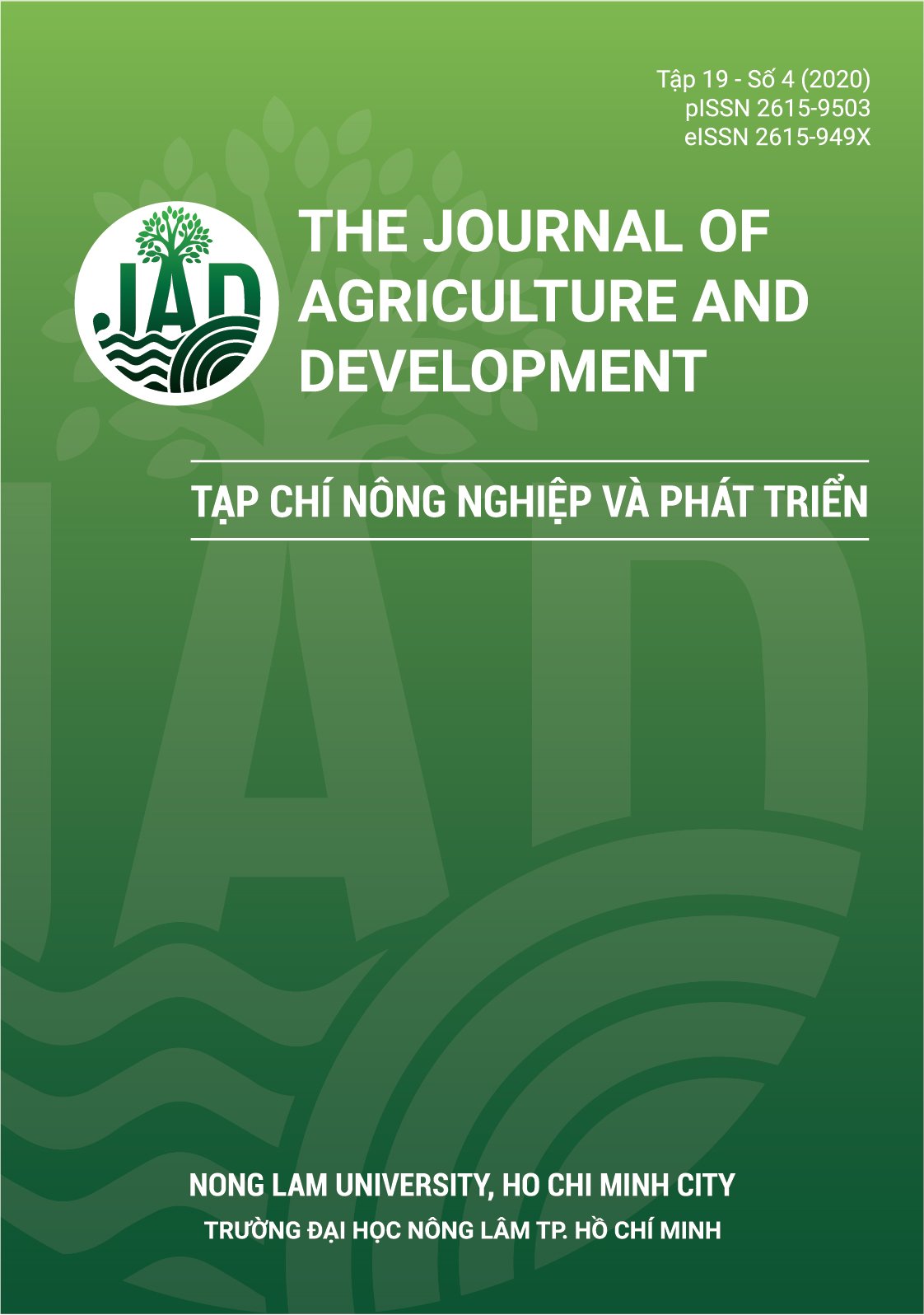Phân tích thành phần hóa thực vật và xác định khả năng chống oxy hóa và kháng khuẩn của dịch chiết từ lá của cây khôi nhung (Ardisia silvestris Pitard)
Main Article Content
Tóm tắt
Khảo sát sơ bộ thành phần hóa thực vật, định lượng một số hợp chất và xác định khả năng kháng khuẩn, khả năng kháng oxy hóa từ lá cây khôi nhung (Ardisia silvestris) đã được thực hiện. Các hợp chất của lá cây khôi nhung được ly trích với dung môi petroleum ether, ethylacetate, ethanol và nước bằng phương pháp ngâm dầm và đánh vi sóng. Khả năng chống oxy hoá của các dịch chiết lá cây khôi nhung được xác định bằng phương pháp DPPH. Khả năng kháng khuẩn Staphylococcu saureus, Samonella sp. và Escherichia coli của các cao chiết lá cây khôi nhung được xác định bằng phương pháp khuếch tán đĩa thạch. Các dung môi petroleum ether, ethyl acetate, ethanol và nước được dùng cho li trích. Kết quả cho thấy lá cây khôi nhung có chứa các hợp chất như tinh dầu, chất béo, alkaloid, flavonoid, coumarin, tanin, anthocyanoid, carotenoid, các acid hữu cơ, chất khử, proanthocyanidin, saponin và anthraquinon. Hàm lượng polyphenol có trong lá cây khôi nhung là 0,26% chất khô. Hàm lượng tanin của lá cây khôi là 8,80%. Hàm lượng Flavonoid của lá cây khôi nhung là 1,442 mg/g. Dịch chiết ethyl acetate và dịch chiết nước của lá cây khôi nhung có khả năng kháng oxy hóa, nhưng thấp hơn so với acid ascorbic lần lượt là 4,2 và 4,4 lần. Dịch chiết ethyl acetate của lá khôi nhung có hoạt tính oxy hóa cao nhất. Các dịch chiết ethyl acetate và dịch chiết ethanol thể hiện rõ tính kháng vi khuẩn thông qua đường kính vòng vô khuẩn, đối với vi khuẩn E.coli lần lượt từ 9,67 mm đến 20,67 mm và Salmonella sp. là 14,67 mm và 15,33 mm, tuy nhiên không thể hiện đối với vi khuẩn Staphylococus aureus.
Article Details
Tài liệu tham khảo
Al-Abd, N. M., Nor, Z. M., Mansor, M., Zajmi, A., Hasan, M. S., Azhar, F., & Kassim, M. (2017). Phytochemical constituents, antioxidant and antibacterial activities of methanolic extract of Ardisia elliptica. Asian Pacific Journal of Tropical Biomedicine 7(6), 569-576. https://doi.org/10.1016/j.apjtb.2017.05.010
Bhattacharyya, P., Kumaria, S., Diengdoh, R., & Tandon, P. (2014). Genetic stability and phytochemical analysis of the invitro regenerated plants of Dendrobium nobile Lindl., an endangered medicinal orchid. Meta Gene 2, 489-504. https://doi.org/10.1016/j.mgene.2014.06.003
Chang, C. C., Yang, M. H., Wen, H. M., & Chem, J. C. (2002). Estimation of flavonoid total content in propolis by two complementary colorimetric methods. Journal of Food and Drug Analysis 10(3), 178-182. https://doi.org/10.38212/2224-6614.2748
Dai, J., & Mumper, R. J. (2010). Plant phenolics: extraction, analysis and their antioxidant and anticancer properties. Molecules 15(10), 7313-7352. https://doi.org/10.3390/molecules15107313
Do, T. L. (2004). Vietnamese medicinal plants and herbs. Ha Noi, Vietnam: Medical Publishing House.
Fu, L., Xu, B. T., Xu, X. R., Gan, R. Y., Zhang, Y., Xia, E. Q., & Li, H. B. (2011). Antioxidant capacities and total phenolic contents of 62 fruits. Food Chemistry 129(2), 345-350. https://doi.org/10.1016/j.foodchem.2011.04.079
Giang, K. T., Nguyen, M. T., Pham, H. V., Pham, D. T. H., & Duez, P. (2011). Effect of quality of material on polyphenol content and antibacterial activity of pH tea varieties. Journal of Science and Development 9(2), 258-264.
Grotewold, E. (2007). The science of flavonoids. New York, USA: Springer Publishing House.
Kikuzaki, H., Hisamoto, M., Hirose, K., Akiyama, K., & Taniguchi, H. (2002). Antioxidant properties of ferulic acid and its related compounds. Journal of Agricultural and Food Chemistry 50(7), 2161-2168. https://doi.org/10.1021/jf011348w
Kobayashi, H., & de Mejia, E. (2005). The genus Ardisia: a novel source of health-promoting compounds and phytopharmaceuticals. Journal of Ethnopharmacol 96(3), 347-354. https://doi.org/10.1016/j.jep.2004.09.037
Le, T. M., Nguyen, T. H, Pham, T. T., Nguyen T. H, & Le, T. L. C. (2005). Methods of analysis for fermentation technology. Hanoi, Vietnam: Science and Technics Publishing House.
Ling, L. F., & Subramaniam, S. (2007). Biochemical analyses of Phalaenopsis violacea orchid. Asian Journal Biochemistry 2(4), 237-246.
MOH (Ministry of Health) (2010). Vietnam pharmacopoeia IV. Ha Noi, Vietnam: Medical Publishing House.
Nguyen, P. K. T. (2007). Methods of isolation of organic compounds. Ho Chi Minh City, Vietnam: National University Publishing House.
Nguyen, T. P. (1999). Handbook for searching and identifying families of angiosperms in Vietnam. Ha Noi, Vietnam: Agricultural Publishing House.
Tran, L. T. K (2002). Study on chemical composition and biological activity of some Ardisia species of Myrsinaceae family in Vietnam (Unpublished Doctoral dissertation). Vietnam Academy of Science and Technology, Ha Noi, Vietnam.
Zhu, H., Wang, Y., Liu, Y., Xia, Y., & Tang, T. (2009). Analysis of flavonoids in Portulaca oleracea L. by UV- Vis spectrophotometry with comparative study on different extraction technologies. Food Analytical Methods 3(2), 90-97. https://doi.org/10.1007/s12161-009-9091-2








